The Best of The Little Rascals in 3D Blu-ray Movie
HomeThe Best of The Little Rascals in 3D Blu-ray Movie 
Our Gang / Blu-ray 3D + Blu-rayLegend | 1931-1938 | 84 min | Not rated | Oct 30, 2012
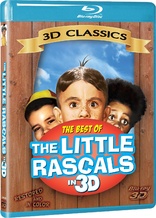
Movie rating
7.4 | / 10 |
Blu-ray rating
| Users | 0.0 | |
| Reviewer | 2.5 | |
| Overall | 2.5 |
Overview
The Best of The Little Rascals in 3D (1931-1938)
Spanky, Buckwheat, Porky and all of the Little Rascals at their hilarious best! The Gang has never looked this good - restored, in color and now available in this stunning stereoscopic 3D transfer!
Director: Robert F. McGowan| Comedy | 100% |
Specifications
Video
Video codec: MPEG-4 MVC
Video resolution: 1080p
Aspect ratio: 1.34:1
Original aspect ratio: 1.37:1
Audio
English: DTS-HD Master Audio Mono
Subtitles
None
Discs
25GB Blu-ray Disc
Single disc (1 BD)
Blu-ray 3D
Playback
Region free
Review
Rating summary
| Movie | 2.5 | |
| Video | 3.0 | |
| Audio | 2.5 | |
| Extras | 0.0 | |
| Overall | 2.5 |
The Best of The Little Rascals in 3D Blu-ray Movie Review
Spanky and His Gang.
Reviewed by Jeffrey Kauffman December 2, 2012Hal Roach’s legendary Our Gang series, which was renamed The Little Rascals for television in a rather arcane set of rights issues involving Roach and Metro-Goldwyn-Mayer, debuted in 1922 in the silent film era with the short called One Terrible Day. An astounding 22 years later, the final film in the series, Dancing Romeo, appeared in the spring of 1944. Over the course of those two decades-plus, 220 shorts were produced, offering an adoring public the then unusual chance to see both Caucasian and African American children appearing together as more or less equals. Many of the Our Gang cast became very famous, at least for a time, including such standouts as Carl “Alfalfa” Switzer and Ernie “Sunshine Sammy” Morrison. Notable stars like Jackie Cooper passed through the ranks of the Gang at one time or another, but in the unintended irony department, when replacement cast members had to be found and huge national searches were undertaken, icons like Shirley Temple were passed over, forced to seek their fame and fortune elsewhere. If the rights issues that led to Our Gang being redubbed The Little Rascals were rather labyrinthine, they pale in comparison to what has happened during the home video era, where a number of different labels have brought out various versions of the shorts on VHS, DVD and, now, Blu-ray. Legend Films gained its foothold in the home video market with its colorized versions of various films, including several Our Gang comedies, and it has now revisited five of those colorized shorts by sprucing them up with the other technological treat the label is well known for, 3D post-conversion.
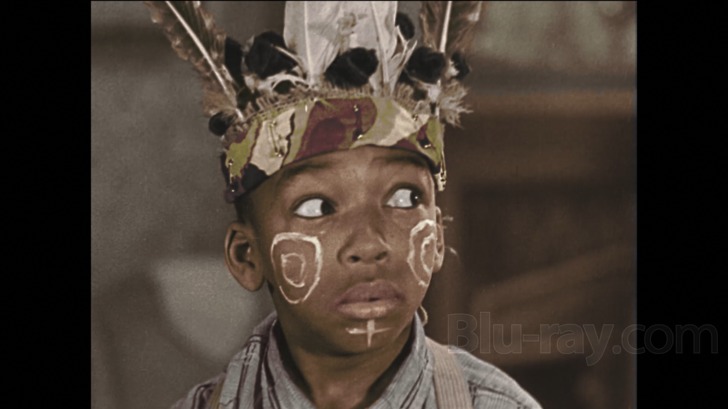
The five shorts included on this compilation are:
Fly My Kite (1931). This kind of bizarre combination of pathos and hilarity might remind some of those old theatrical presentations where the hapless young woman is about to lose her homestead to the mustache twirling evil landlord, only in this instance the woman is an elderly lady called Grandma (Margaret Mann), and the villain is actually her scheming son-in-law (Jim Mason). This piece is often a riot of slapstick invention, for the son-in-law is trying to literally get his hands on some lucrative bonds that Grandma isn’t aware are worth a fortune, while the kids repeatedly use every arsenal at their disposal to try to keep him from gaining access to them. Often laugh out loud funny, but rather strangely emotionally compelling nonetheless, this is one of the best remembered Our Gang shorts, and it marked the final appearance of Allen “Farina” Hoskins.
A Lad an’ a Lamp (1932). While the fact that Hal Roach exploited the use of both white and black children actors side by side, it also can’t be denied that were often racial stereotypes at play in some of these shorts, despite the adamant rejection of this thesis by some of these very same African American child actors (as adults). A Lad an’ a Lamp is a perfect example. The kids are all intrigued by the story of Aladdin and his lamp and as the film opens they are all madly rubbing various containers hoping for their fondest wish. Some of these are rather mundane, but little black boy Matthew “Stymie” Beard is hoping that his father gets out of jail soon. As if that weren’t bad enough, another subplot has one of the kids wishing that Stymie’s little brother Cotton (Bobbie Beard) would be turned into a monkey, something that kind of happens through a case of mistaken identity. It’s all played for laughs, of course, but some modern day sensibilities may find this kind of thing well over the line of what’s now considered politically correct.
The Kid From Borneo (1933). This is another problematic entry in the series which sees the kids trying to meet up with the mysterious Uncle George, who runs a carnival that has come to town. Instead they meet up with a half witted native called The Wild Man from Borneo, whom the children mistake for Uncle George. That of course leads to all sorts of calamity, especially after they bring the wild man home to interact with the rest of George’s family. This short is undeniably funny at times, but it also posits a savage black who seems to be mentally handicapped. As such, it was deemed unsuitable for the emerging politically correct consciousness of the 1970s and was withdrawn from syndication at that time.
Hi’ Neighbor (1934). This is a sweet little entry in the series that focuses on jealousy between the Gang kids and a newcomer to the neighborhood. This also features some hilarious moments with Spanky nonplussed by his friends’ attempts to compete with their rich new neighbor’s toy fire engine by building one of their own. This short marked a sea change in the history of Our Gang, as Roach’s go-to director, Robert F. McGowan, was seriously burnt out and left the series to pursue feature work at Paramount (this wouldn’t preclude him from working with Our Gang alumni, as he did with Carl “Alfalfa” Switzer in 1936’s Too Many Parents, Frances Farmer’s feature film debut). There’s no real change in style or approach despite this being under the direction of Gus Meins, who would go on to helm many of the subsequent Our Gang shorts.
Hide and Shriek (1938). If Hi’ Neighbor marked the departure of Robert F. McGowan, Hide and Shriek was producer-creator Hal Roach’s swan song with his long running series. This is one of the briskest, most satisfying shorts in the Roach Gang canon, positing Carl “Alfalfa” Switzer as a deerstalker hatted detective who is out to track down what has become of Darla’s missing candy. Buckwheat and Porky meanwhile have blundered into a haunted house at an amusement park and are reeling from the scares found inside the ghoulish mansion. There’s nothing unexpected or especially innovative about this final Roach entry, but it shows the absolute craftsmanship Roach brought to this series, with Alfalfa especially winning in his own kind of “Sherlock Jr.” role. The Our Gang shorts would continue under the aegis of Metro-Goldwyn-Mayer for another six or so years, but their quality rapidly declined after Roach’s exit, never again regaining the simple but effective luster that had been their hallmark for so many years.
The Best of The Little Rascals in 3D Blu-ray Movie, Video Quality 
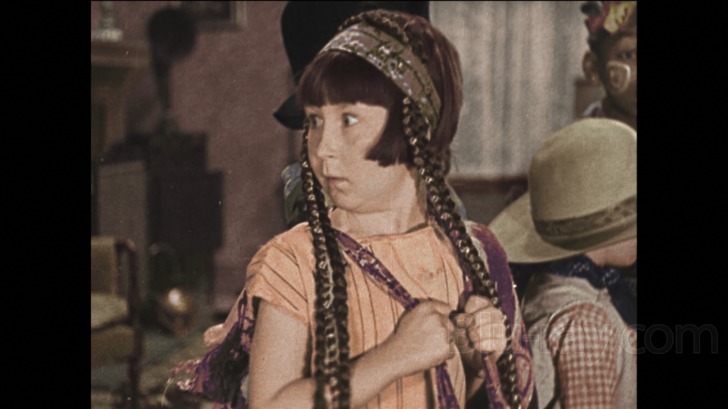
The Best of The Little Rascals in 3D is presented on Blu-ray courtesy of Legend Films imprint 3D Classics with both an
MVC (3D) and AVC (2D) encoded 1080p transfer in 1.34:1. Legend tends to do nicely understated work with their
colorizing, as evidenced by several previous releases like March of the Wooden Soldiers and The Ray Harryhausen Double Feature. The label tends to
work with public domain material, but it also tends to feature transfers culled from decent elements, or at least elements
that have undergone significant restoration. The five shorts here are all reasonably free of age related wear and tear, and
the basic image is okay looking, within reasonable expectations. The colorization is perhaps a bit more pallid than is typical
even of Legend releases, which have never really slathered on the color to the point of making a previous black and white
film look like a Paintshop nightmare.
While the same care seems to have been granted these Little Rascals shorts in terms of their 3D post-conversion as
was shown in Legend's commendable work on The Three Stooges in 3D, for whatever reason, the results are somewhat less vivid here, with
markedly less depth and dimensionality. The best sequences here tend to be those that take place out of doors, where
depth of field increases exponentially and foreground objects are more clearly differentiated from those in the background.
It's perhaps instructive to note that taking the 3D glasses off while watching these shorts in 3D mode reveals very little
stereoscopic tinkering to the image, which may account for some of the lack of dimensionality.
The Best of The Little Rascals in 3D Blu-ray Movie, Audio Quality 

The Best of The Little Rascals in 3D features a lossless mono track delivered via DTS-HD Master Audio 2.0. There are some occasional skips and missing syllables in these features, but overall, things sound reasonably spry, given the age of the shorts. Fidelity is about what you'd expect, with boxy, tinny sounding music but better, full bodied sound in the dialogue. There's noticeable hiss and some high frequency distortion at play in many of these shorts, but it's not overly distracting. Dynamic range is negligible.
The Best of The Little Rascals in 3D Blu-ray Movie, Special Features and Extras 
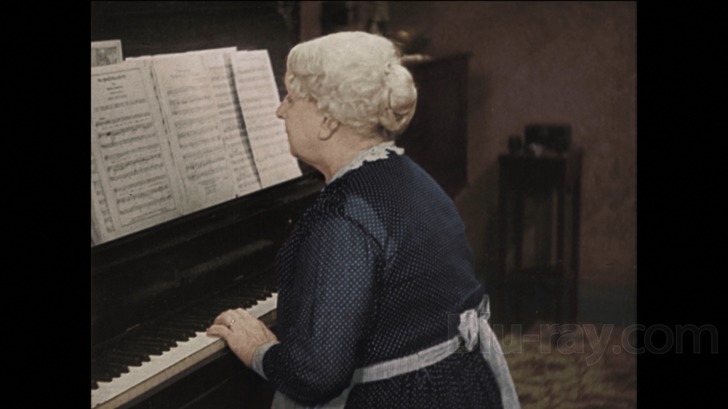
No supplements of any kind are included on this Blu-ray disc.
The Best of The Little Rascals in 3D Blu-ray Movie, Overall Score and Recommendation 
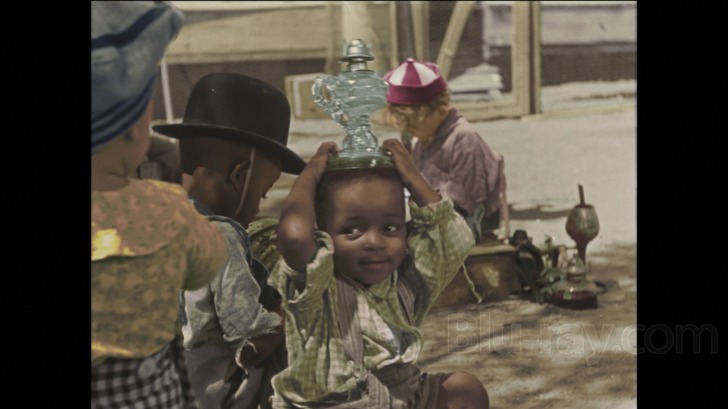
I'm not quite sure what the market is for these hoary old comedy classics in 3D, but for those who want to see Spanky, Alfalfa and the rest of Our Gang leaping out at them (if only minimally), this set is an interesting if somewhat problematic compilation that includes a couple of real winners along with two entries that may serve more as "instructional videos" on how far we've come in terms of race relations and stereotyping. The basic image quality here is fine, if uninspiring, but the 3D conversion, while not presenting any real technical problems, also doesn't really provide a whale of a lot of depth and dimensionality.
Similar titles
Similar titles you might also like

The Three Stooges in 3D
1936-1949

Cats & Dogs: The Revenge of Kitty Galore 3D
2010

Cruella 4K
2021

Treasure Buddies
DVD Packaging
2012

The Muppets
2011

Beverly Hills Chihuahua 2
2010

Paddington
2014

Diary of a Wimpy Kid: Dog Days
2012

Mr. Popper's Penguins
2011

Alexander and the Terrible, Horrible, No Good, Very Bad Day
2014

Santa Paws 2: The Santa Pups
2012

Beverly Hills Chihuahua 3: Viva la Fiesta!
DVD Packaging
2012

Diary of a Wimpy Kid
2010

Diary of a Wimpy Kid: Rodrick Rules
2011

Garfield: A Tail of Two Kitties
2006

Garfield: The Movie
2004

The Santa Clause 2
10th Anniversary
2002

Middle School: The Worst Years of My Life
2016

Easter Sunday
2022

Hotel for Dogs
2009